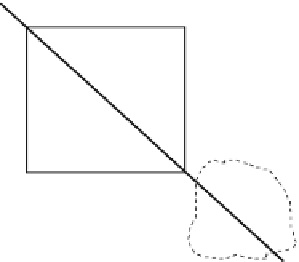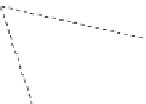Information Technology Reference
In-Depth Information
Fig. 7.1
A shadowbox is
where subjects may exchange
information about images in
order to identify an object
from its
shadow
projection(s)
Image for
Observer
A
Agreed
Object
Image for
Observer
B
Table 7.1
Relationship between a set of observations and a set of hypothesized objects
Phenomenology
hypothesized
objects
Circle
Triangle
Square
Point-
circle
(oblique)
Circle-
point
(oblique)
Point-
square
(oblique)
Square-
point
(oblique)
Items
in
phenom-
enology
Sphere
Ye s
No
No
No
No
No
No
1
Cone
Ye s
Ye s
No
Ye s
Ye s
No
No
4
Pyramid
No
Ye s
Ye s
No
No
Ye s
Ye s
4
Objects
implied
2
2
1
1
1
1
1
-
symmetrical object. A sphere has only one 2-D projection, a circle (see Table
7.1
).
But if an observer then sees, say, a triangle, the sphere hypothesis must be set aside
in favour of an object (or set of objects) that could have both circular and triangular
projections.
In this example, the experimental procedure is rudimentary. Making an exper-
iment involves looking at one or more faces of the box. This approximates to the
epistemic ideal of direct (i.e. unmediated) observation. Since the phenomenology can
be described using simple, ordinary language descriptors, the example also elimi-
nates another source of complexity in science, miscommunication. Nevertheless, the
example illustrates the essentials of our approach: subjects make
experiments
that
mediate between two partially defined domains: a variable set of
hypotheses
and a
variable set of
phenomena
. They can also
communicate
with other subjects to acquire
additional observations and hypotheses.
Table
7.1
illustrates that the cone and pyramid hypotheses have a richer phe-
nomenology than the sphere. This makes the sphere an easier hypothesis to rule out.
The Venn-diagram in Fig.
7.2
(Venn
1880
) displays this phenomenology as sets of
observables for each hypothesised object, showing where sets overlap or are mutu-
ally exclusive. For example, a sequence of observation reports containing anything
other than a circle will rule out the sphere; similarly, observation of a square will
rule out sphere and cone. The order in which observations are encountered will of
course affect the pattern of belief-revision.





























































